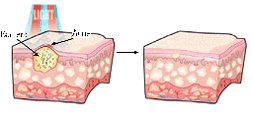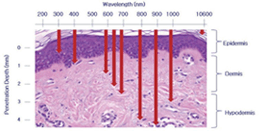 > Research & Development > LED LIGHT THERAPY
> Research & Development > LED LIGHT THERAPYLED LIGHT THERAPY
You can get an answer to questions for LED LIGHT THERAPY.

[Fig. 1]
Founder of Light therapy-
Niels Ryberg Finsen
( 1860~1904)
Light therapy is a medical technic used for the remedy of various diseases for a long time.
To use the Sun light for remedy of skin disease has been done in Egypt, India and China
from thousands years before.
The remedy to use the Sun light was emerged again by NielsRyberg Finsen(Fig.1) of
Nobel Prize for Medicine in 1903, then phototherapy to use artificial light came to be born.
Recently, the way to use LED light is rising among many lamps. While large output laser
cures focusing on a partial area, LED lamp can cure the wide area of disease effectively
with proper light power.LED light has narrow wavelength bandwidth so the light source
of specific wavelength comes out, so harmful UV or unnecessary infrared rays and etc
do not release, and then decreases side effect, low energy does not damage on eyes.
Thanks to these benefits, US FDA gives permission to use the remedy used
by the LED light of visible ray and fore infrared rays to people.
The physical feature of LED lamp has long lifespan, low power consumption,
eco-friendly, small volume, and easy to use the space as its benefits.

LED is the English acronym of light emitting diodes, and means
the semiconductor to come out light when electric current flows.
It includes ultraviolet, visible light, infrared rays and etc, is possible to adjust
the light power and color so popular lamp of medical equipments nowadays.
National Aeronautics and Space Administration(NASA) discovered the fact
that the growth is accelerated about 2.5 to 3 times if plant is exposed to LED.
Then, they did similar experiment to people as well and got the result
that the recovery speed is faster around 40% if we use LED to patients of
back and shoulder pain.

[Source]: Lightstim
[Fig. 2] Examples of acne treatment
through led
Similar to the principle that the Sun light changes to plant cell through
chlorophyll in plant, LED lamp too can induce the light-biochemicalreaction
among cells. Phototheraphy is based on the one that the photon of LED lamp
absorbs to the chromophore or photo- acceptor in cell system and
encourages the metabolic activity of cells.
The whole metabolic activity of cells is done lively so the light plays a big role
to regenerate and rehabilitate cells. If LED lamp is exposed to skin,
production of collagen and elastin is accelerated and wrinkles are
restricted then skin can keep elasticity with moist.
[Fig. 2] is displayed to understand the principle of curing skin disease through
LED lamp easier. If blue LED light is exposed to skin to remove pimples,
bacteria of pimple’s reason will be extinguished, inflammation subsided
and then whole skin condition enhanced.

[Source]: B.W. Pogue, L. Lilge,
M.S. Ppatterson et al., 1997
[Fig. 3] Information of
penetration depth to skin
by the wavelength of light
LED light source is separated by wavelength. Other wavelengths produce
different biochemical reaction in cell system. It is because typically the light
of the long wavelength penetrate into cells deeply. (Fig. 3)
Even if it is different according to the kind of cell tissue, the light of 400nm
wavelength can penetrate less than 1mm depth, 514nm do 0.5~2mm depth,
630nm do 1~6mm depth, and 700~900nm do more deeply. Each cell and
the cell tissue have its own light absorbing characteristics. In other words,
it is to absorb only the light of a certain wavelength. In order to make a
maximum efficiency of light therapy, you have to select the wavelength
available for the light to penetrate into the target cell or cell tissue.
Red color is used to activate the sebaceous glad in the deep layer of skin,
blue one can be used to activate the keratoses in epidermis with PDT
way and adjust the surface condition of skin.
To apply the light therapy with LED lamp, the light of very deep penetration
wavelength is effective.For example, 660nm wavelength light of 2.3mm
penetration depth takes effect from fibroblast to reti- cular dermis.
LED lamp should have the range of wavelength for molecule chromophore
or photoreceptor to absorb well.

① Wound healing
The remedy of skin disease with LED light in early days targeted on wound healing. LED light of various wavelengths from visible light and fore infrared ray’s area increased the growth of cells in lots of cell line such as murine myofibroblast, osteoblast of mouse, skeletal muscle cell of mouse, human epithelial cell and etc. The result of study on reduction of scar size and increase of seaming scar speed was published, especially positive study result on quick wound healing and seam of human skin cell was come out. Especially when LED light is exposed after surgical operation, it is reported that the side effect such as swelling, oozing, crus- ting, pain, and erythemaremarkably decreased. It is reported that increase of making metalloproteinases with the wavelength of fore infrared rays area helped to heal the wound to cure the skin with necrotic wound.
② Anti-inflammatory
LED light of 635nm restricts COX and cy- clooxygenase prostaglandin E2 then protects the cells in the condition of specific pathology such as inflammation. In other words, LED light of 635nm wavelength is to protect the cells possible to have inflammation.LED light of 635 nm wavelength restricts the expression of COX and cy- clooxygenase prostaglandin E2 one of hormone materials, so can be the effective light therapy wavelength to anti-inflamatory.
③ Oral mucositis
For 34-year old male patient of oral mucositis, when putting the tool that LED chip of 880 nm wavelength is made by array into his mouth, doing chemical therapy with the light intensity of 3.6 J/cm2, 74 mW, then exposing to the light for 5 days, clinical result is reported to protect the spread of oral mucositis. Based on this result, it was verified that light therapy with LED light of 880 nm wavelength is a safe and effective way to prevent the oral mucositis.
④ Venous ulcer
If exposing the LED light of 660nm wavelength and 890 nm wavelength on vein at the same time, it was reported to be effective for healing vein.
⑤ Icterus neonatorum
If exposing the LED light of 450 nm wavelength on newborn babies who passed about 12~144 hours after birth for 8 days, it was checked clinically that around 50% newborn babies were healed from icterus.
⑥ Skin rejuvenation
When it comes to the skin damaged by Sun light, collagen synthesis reduces along with the increase of MMP. Therefore, the strategy to prevent or treat medical signs of skin aging is possible with the way of solving the lack of collagen through reducing MMP and making new collagen. It is reported that using lots of LED light to emit the light corresponding to the wavelength of visible light and fore infrared ray area can strengthen the composition of collagen from skin and also restrict the increase of MMP. Remarkable increase of collagenesis after exposing LED light is being reported by lots of experiment.
⑦ Skin Keratosis
This is the field that the clinical therapy effect is being checked by photodynamic therapy: PDT based on LED. If exposing the LED light of120 mW/cm2(40 J/cm2) to patients of UV Keratosis, it was checked that 80.3% of patients were cured after 6 months. It was checked that PDT LED light-based treatment is safe and effective, for future treatment of skin keratosis it is suggested that incoherent LED light can be used with effective replacing light.
⑧ Sun burn prevention
The light of fore infrared rays among visible light can prevent the damage from light of skin. Such possibility is supported by nonclinical experiment for prevention of cell tissue damage by UV after exposing IR light on human fibroblast. That is, skin exposed by LED light can have strong resistance for UV light. If exposing the light of 660nm wavelength before exposed to UV, it is reported that erythema from UV-B can be restricted. In the future, induction of cell resistance for UV through these methods will be able to converse the traditional skin protection way such as UV sunblock dramatically.
| Wavelength range | Sortation | Action effect, and applications area |
Using LED light |
|---|---|---|---|
| UV-C | far ultraviolet ray (100~280 nm) |
• Sterilization and Clarification • Bio-medicla sensor |
LED light source, (250 nm) |
| UV-B | mid-ultraviolet ray (280~320 nm) |
• formation of Vitamin D • Vitiligo, Psoriasis a curer |
LED(315 nm) |
| UV-A | near ultraviolet rays (320~400 nm) |
• Atopic dermatitis therapy • Systemic sclerosis, mycosis therapy |
LED(362, 380 nm) |
| visible light | R, G, B (400~780 nm) |
• Icterus neonatorum therapy • Acne, Melasma therapy • skin improvement, therapy of optic nerve • Depression, appreciation of the beautiful therapy |
LED all range |
| IR-A | near infrared ray (780nm~2.5㎛) |
• Pain relief • Facilitate the regeneration of skin • Facilitate suture the affected area after surgery. |
LED(830 nm) |
dissertation
[1] Skin disease with LED technology trends and market opportunities for analysis - Korea Institute of Science and Technology Information
[2] LED therapy for the treatment of skin diseases - Korea Electronics and Telecommunications Research Institute
[3] R. Roelandts, “A New Light on Niels Finsen, a Century after His Nobel Prize,” Photodermatol Photoimmunol. Photomed., Vol.21, 2005, pp.115-117.
[4] D. Barolet, “Light-Emitting Diodes(LEDs) in Dermatology,” Seminars in Cutaneous Medicine and Surgery, Vol.27, 2008, pp.227-238.
[5] M.R. Hamblin and T.N. Demidova, “Mechanisms for Low-Light Therapy,” Proc. SPIE, Vol. 6140, 2006, pp.1-12.
[6] K. Kalka, H. Merk, and H. Mukhtar, “Photodynamic Therapy in Dermatology,” J. Am. Acad. Dermatol., Vol.42, 2000, pp.389-413.
[7] C.R. Simpson, M. Kohl, M. Essenpreis et al., “Near Infrared Optical Properties of Ex-vivo Human Skin and Subcutaneous Tissues Measured
Using the Monte Carlo Inversion Technique,” Phys. Med. Biol., Vol.43, 1998, pp.2465-2478.
[8] B.W. Pogue, L. Lilge, M.S. Patterson et al., “Absorbed Photodynamic Dose from Pulsed Versus Continuous Wave Light Examined with
Tissue-simulating Dosimeters,” Appl. Opt., Vol.36, 1997, pp.7257-7269.
[9] T.I. Karu, L.V. Pyatibrat, and G.S. Kalendo, “Photobiological Modulation of Cell Attachment via Cytochrome c Oxidase,” Photochem.
Photobiol. Sci., Vol.3, 2004, pp.211-216.
[10] H.T. Whelan, R.L. Jr. Smits, E.V. Buchman et al., “Effect of NASA Lightemitting Diode Irradiation on Wound Healing,” J. Clin. Laser Med.
Surg., Vol.19, 2001, pp.305-314.


